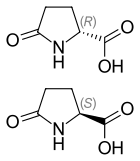Pyroglutamic acid (also known as PCA, 5-oxoproline, pidolic acid) is a ubiquitous but understudied natural amino acid derivative in which the free amino group of glutamic acid or glutamine cyclizes to form a lactam.[1] The names of pyroglutamic acid conjugate base, anion, salts, and esters are pyroglutamate, 5-oxoprolinate, or pidolate.
 | |
| Names | |
|---|---|
| Preferred IUPAC name 5-Oxoproline | |
| Systematic IUPAC name 5-Oxopyrrolidine-2-carboxylic acid | |
Other names
| |
| Identifiers | |
3D model (JSmol) | |
| 3DMet | |
| Abbreviations | Glp |
| 82134 | |
| ChEBI |
|
| ChEMBL | |
| ChemSpider | |
| DrugBank | |
| ECHA InfoCard | 100.005.227 |
| EC Number |
|
| 1473408 | |
| KEGG | |
| MeSH | Pyrrolidonecarboxylic+acid |
PubChem CID | |
| RTECS number |
|
| UNII |
|
CompTox Dashboard (EPA) | |
| |
| |
| Properties | |
| C5H7NO3 | |
| Molar mass | 129.115 g·mol−1 |
| Melting point | 184 °C (363 °F; 457 K) |
| log P | -0.89 |
| Acidity (pKa) | -1.76, 3.48, 12.76 |
| Basicity (pKb) | 15.76, 10.52, 1.24 |
| Isoelectric point | 0.94 |
| Related compounds | |
Related compounds | proline 2-Pyrrolidone |
Except where otherwise noted, data are given for materials in their standard state (at 25 °C [77 °F], 100 kPa). | |

It is a metabolite in the glutathione cycle that is converted to glutamate by 5-oxoprolinase. Pyroglutamate is found in many proteins including bacteriorhodopsin. N-terminal glutamic acid and glutamine residues can spontaneously cyclize to become pyroglutamate, or enzymatically converted by glutaminyl cyclases.[2] This is one of several forms of blocked N-termini which present a problem for N-terminal sequencing using Edman chemistry, which requires a free primary amino group not present in pyroglutamic acid. The enzyme pyroglutamate aminopeptidase can restore a free N-terminus by cleaving off the pyroglutamate residue.[3]
Pyroglutamic acid exists as two distinct enantiomers:
- (2R) or D which happens to be (+) or d
- (2S) or L which happens to be (–) or l
Metabolism
As first discovered in 1882, pyroglutamic acid can be formed by heating glutamic acid at 180 °C, which results in the loss of a molecule of water. In living cells, it is derived from glutathione through the action of an enzyme, γ-glutamyl cyclotransferase.[1] Pyroglutamic acid may function in glutamate storage, and acts to oppose the action of glutamate, including in the brain.[1] It also acts on the brain's cholinergic system;[4] Amyloid β containing pyroglutamic acid is increased in Alzheimer's disease; this may be part of the disease process.[5]Increased levels of pyroglutamic acid in the blood, leading to excess in the urine (5-oxoprolinuria), can occur following paracetamol overdose, as well as in certain inborn errors of metabolism, causing high anion gap metabolic acidosis.[1][6]
Uses
The sodium salt of pyroglutamic acid—known either as sodium pyroglutamate, sodium PCA, or sodium pidolate—is used for dry skin and hair products, as it is a humectant. It has low toxicity and is not a skin irritant, but its use in products is limited by a high price.[7][8]
L-pyroglutamic acid is sold online as a nootropic dietary supplement.[9][10]
Magnesium pidolate, the magnesium salt of pyroglutamic acid, is found in some mineral supplements.In a preclinical study, additional pharmacological properties of pyroglutamic acid were revealed such as anti-phosphodiesterase type 5, anti-angiotensin-converting enzyme, and anti-urease activities.[11]